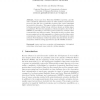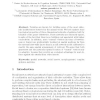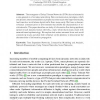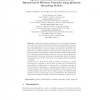126
click to vote
BIOWIRE
2007
Springer
15 years 4 months ago
2007
Springer
Chemical computing models have been proposed since the 1980ies for expressing concurrent computations in elegant ways for shared memory systems. In this paper we look at the distri...
BIOWIRE
2007
Springer
15 years 4 months ago
2007
Springer
126
click to vote
BIOWIRE
2007
Springer
15 years 4 months ago
2007
Springer
Desynchronization is a novel primitive for sensor networks: it implies that nodes perfectly interleave periodic events to occur in a round-robin schedule. This primitive can be us...
116
click to vote
BIOWIRE
2007
Springer
15 years 7 months ago
2007
Springer
Sensor and Actor Networks (SANETs) represent a specific class of massively distributed systems in which classical communication protocols often fail due to scalability problems. N...
BIOWIRE
2007
Springer
15 years 7 months ago
2007
Springer
Abstract. Termites are known for building some of the most elaborate architectures observed in the animal world. We here analyse some topological properties of three dimensional ne...
118
click to vote
BIOWIRE
2007
Springer
15 years 7 months ago
2007
Springer
Emerging pervasive computing technologies such as sensor networks and RFID tags can be embedded in our everyday environment to digitally store and elaborate a variety of informatio...
101
click to vote
BIOWIRE
2007
Springer
15 years 7 months ago
2007
Springer
The emergence of Delay Tolerant Networks (DTNs) has culminated in a new generation of wireless networking. New communication paradigms, which use dynamic interconnectedness as peop...
120
click to vote
BIOWIRE
2007
Springer
15 years 7 months ago
2007
Springer
Vehicular sensor networks (VSNs) provide a collaborative sensing environment where mobile vehicles equipped with sensors of different nature (from chemical detectors to still/video...
109
click to vote
BIOWIRE
2007
Springer
15 years 7 months ago
2007
Springer
In this chapter, we present some of the biologically-inspired approaches, developed within the context of the European project BIONETS for enabling autonomic pervasive computing en...
170
click to vote
BIOWIRE
2007
Springer
15 years 7 months ago
2007
Springer
Epidemics-inspired techniques have received huge attention in recent years from the distributed systems and networking communities. These algorithms and protocols rely on probabili...




